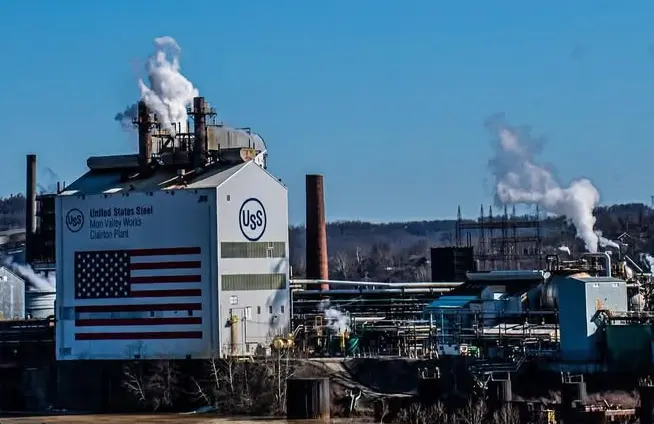What is Clariton Coke Works? Pittsburgh residents mourn after explosion kills 2 and injures 10
-
 Clairton Coke Works (Image via Instagram/@traingeekdee)
Clairton Coke Works (Image via Instagram/@traingeekdee)A blast at U.S. Steel's facility, the Clairton Plant, also known as the Clairton Coke Works, continues to impact workers' lives, as two of the workers died and 10 others were injured in a recent incident. Witnesses described a large blast shortly before 11:20 a.m. on Monday, sending thick black smoke into the air and rattling buildings across the Mon Valley, a long-time steel hub.
The Clairton Plant is the largest coke-making plant in North America and produces good-quality metallurgical coke necessary for manufacturing steel.
According to WCVB News, Coke is made when coal is heated in ovens at very high temperatures, and for long periods, which produces coke and removes impurities from the coal that might make the steel weak.
VIDEO: CMU CREATE Lab/ Breathe Project captured the moment of an explosion at Clairton Coke Works. pic.twitter.com/knk2LxffLI
— 100.1 FM and AM 1020 KDKA (@KDKARadio) August 11, 2025
The ovens create coke gas, a dangerous mix of methane, carbon dioxide, and carbon monoxide, which produces fire hot enough to melt iron ore in a blast furnace.
The plant runs 24 hours a day and produces about 4.3 million tons of coke each year. The coke batteries, which are long runs of brick ovens that can withstand the heat, serve other U.S. Steel facilities in the Pittsburgh area and beyond.
The Clairton Coke Works has been operating for over 100 years, but has constantly been under scrutiny for safety and environmental issues. Past accidents have taken lives and caused serious injuries, and the facility also has a history of violating air pollution regulations.
A look into recent and past accidents at the Clairton Coke Works
The recent explosion at the Clairton Coke Works supposedly caused a series of smaller explosions, which were reported to the Allegheny County Emergency Services. Emergency services personnel worked several hours to stabilize the site by searching for missing workers and containing gases at the scene.
According to the Associated Press, emergency services agencies ultimately were able to find one worker alive in the debris, hours after the initial explosion. The hospitals in the region treated multiple victims, almost all of whom were released from care within hours, although some occupancy remains.
The cause of the explosion is not yet known. U.S. Steel, a subsidiary of Japan-based Nippon Steel Corp., said it would fully cooperate with the investigation.
"I end every meeting and every message with the words, ‘Let’s get back to work safely.’ That commitment has never been more important, and we will honor it," U.S. Steel CEO David B. Burritt said in a statement.
🚨🔥 MASSIVE EXPLOSION & FIRE at US Steel Clairton Coke Works, Pennsylvania! 🔥🚨
A thunderous blast rocked the largest coke production plant in North America earlier today near Pittsburgh — triggering a Level 3 Mass Casualty Incident. Emergency crews are rushing to the scene… pic.twitter.com/JVeakCB2er
— Technical Master (@BelievInJustice) August 11, 2025
This is not the first time the company has faced scrutiny and backlash for its management. In 2019, U.S. Steel settled an $8.5 million lawsuit regarding air quality issues, promising improvements to various equipment and reductions in emission levels at the plant
This lawsuit was launched due to an incident in 2018 at the facility, which caused $40 million in damages and resulted in weeks of sulfur dioxide emissions and related health warnings for the surrounding community.
After the disaster in 2018, researchers conducted studies and found that members of the local community reported increased sources of asthma and respiratory infections.
Environmental organizations, such as PennEnvironment, are now calling for a comprehensive and independent investigation into the most recent disaster at the Clairton Coke Works, to check whether the facility has continued to operate at all.
TOPICS: Human Interest, David B. Burritt, Clairton Coke Works, Clairton Plant, Mon Valley, Nippon Steel Corp., U.S. Steel
- Japanese woman who broke off engagement with her fiancé on ChatGPT's advice, gets married to an AI chatbot
- Who is Lorna Luxe married to? Lifestyle influencer shares her husband's emergency health update amid stage 4 cancer battle
- Does Jason Kelce want to be home alone for the holidays? NFL dad jokes about family on New Heights podcast
- Did Taylor Swift subtly address her breakups with Joe Alwyn and Matty Healy? Pop superstar reflects on finding purpose on tour